DIY: Make lip balm
Getting started with your essential oils? Make your own lip balm. Delicious in the cold period of the year, or just to protect your lips a bit more during the sunny times. How fun is it to make your own lip balm!
SUPPLIES
PREPARATION
- Fill a small (sauce)pan with water and bring it to a boil. Then place a melting pot on the pan of boiling water, so that the steam from the boiling water heats it.
- Place the coconut oil, shea butter and beeswax in the melting pan and let it melt slowly (au bain-marie).
- Once everything has melted, remove the melting pot from your other pot and let the mixture cool slightly. 💡 TIP: I personally place the melting pot on a tea towel on the counter.
- Add three drops of your chosen essential oil and possibly some mica powder to the mixture and stir until well incorporated and it is nice and smooth.
- Divide your mixture into the three 15 ml (bamboo) jars, or go for one large jar, and let it cool (in the fridge).
And there you have it, let's spread it on!
TIPS & TRICKS
💡 TIP: Prefer to watch a video? Check out the highlight 'DIY Lip Balm' on our Instagram account .
💡 TIP: The recipe above is enough to fill three 15 ml jars. Want to make three different lip balms? First fill the three jars with the melted mixture and then add a drop of essential oil per jar and optionally use three different colors of mica powder. The more mica powder, the more color and glitter!
💡 TIP: If you think one drop of essential oil per 15 ml jar is too much (or too strong), use a cocktail stick. Place the stick in the hole of your oil bottle and make sure your essential oil ends up on the stick by swirling the bottle slightly. Then stir the mixture in your bamboo jar with the stick to mix the essential oil through the mixture.
NOTE: Always choose essential oils that will not be harmful if ingested in small amounts.


_____
*Disclaimer:
It is very important that you use 100% pure essential oils and that you are well informed about which oils you can take responsibly and which oils you cannot take.
There is a potential interaction between medications and essential oils, including an increase in the side effects of medications. Consult your physician if you have any questions about implementing essential oils into your daily routine. Pay particular attention to which essential oil is safe to use in the event of a (possible) pregnancy and when using blood thinners. Special guidelines also apply to children. Consult a qualified physician for this.
This information has been compiled with the utmost care. It is not intended to diagnose, treat, cure or prevent disease, nor is it intended to replace medical advice from professional physicians and medicines. Anyone suffering from illness or injury should consult a qualified physician.
_____